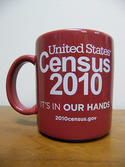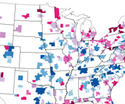Los Angeles Slips Below 2010 Population: New State of California Estimates
The state Department of Finance (DOF) has reported, in its official population estimates, that California continued to lose population during calendar year 2022 read more »
More Census 2010 Features
Tarnishing the Golden State
No state advertises its egalitarian bona fides more than California. Governor Gavin Newsom brags that his state is “the envy of the world,” a place that is “not going to abandon our poor people.” In his inauguration speech, he claimed that “unlike the Washington plutocracy, California isn’t satisfied serving a powerful few on one side of the velvet rope. The California Dream is for all.” read more »
A Tale of 273 Cities
It was the best of times, it was the worst of times; it was the age of wisdom, it was the age of foolishness; it was the epoch of belief, it was the epoch of incredulity; it was the season of light, it was the season of darkness; it was the spring of hope, it was the winter of despair.
Charles Dickens, A Tale of Two Cities
Since 1790, 273 cities have made an appearance on the list of the nation’s 100 largest places. read more »
- Login to post comments
Is the Census Bureau On Track For Another Estimating Fiasco?
When the 2010 Census results were released, a number of big cities had populations that were very off from what would have been expected based on the Census Bureau’s previous annual estimates of the population – sometimes grossly so. Some of these were related to cities that had challenged the estimates and had adjustments made in their favor, such as Cincinnati and St. Louis. Given that the Census Bureau seems to have approved every challenge, bogus challenges were all but encouraged. Still, there were significant variances in cities that didn’t challenge the Census, such as Chicago and Phoenix. read more »
Aging America: The Cities That Are Graying The Fastest
Notwithstanding plastic surgery, health improvements and other modern biological enhancements, we are all getting older, and the country is too. Today roughly 18.5% of the U.S. population is over 60, compared to 16.3% a decade ago; by 2020 that percentage is expected to rise to 22.2%, and by 2050 to a full 25%.
Yet the graying of America is not uniform across the country — some places are considerably older than others. The oldest metropolitan areas, according to an analysis of the 2010 census by demographer Wendell Cox, have twice as high a concentration of residents over the age of 60 as the youngest. In these areas, it’s already 2020, and some may get to 2050 aging levels decades early. read more »
Core City Growth Mainly Below Poverty Line
Over the toughest economic decade since Great Depression, the nation's core cities continued to gain more than their share the below poverty line population in the 51 metropolitan areas with more than 1,000,000 population. Between 2000 and 2010, core cities (Note 1) attracted approximately 10 percent of the increase in population (Note 2) while adding 25 percent of the increase in people under the poverty line (Figure 1). read more »
Misreferencing Misoverestimated Population
I know the media confusion story of the past week is all about the momentary misreporting that got the story of the Supreme Court ruling backwards. Yet there was some real misoverestimating across the nation over the latest census numbers that were released recently on municipal population estimates for 2011. read more »
Staying the Same: Urbanization in America
The recent release of the 2010 US census data on urban areas (Note 1) shows that Americans continue to prefer their lower density lifestyles, with both suburbs and exurbs (Note 2) growing more rapidly than the historic core municipalities. This may appear to be at odds with the recent Census Bureau 2011 metropolitan area population estimates, which were widely mischaracterized as indicating exurban (and suburban) losses and historical core municipality gains. read more »
Population Change 2010-2011: Interesting Differences
The recently released estimates of population change and the natural increase and migration components of that change for 2010-2011 contain a few surprises, as well as much what has come to be expected. What we population freaks have been awaiting are estimates of the components of change for the whole 2000-2010 decade, but these are still being adjusted, in part because of the tremendous complexity of migration and immigration and, yes, estimating just who is in the country! read more »
The Shifting Landscape of Diversity in Metro America
Census 2010 gave the detail behind what we’ve known for some time: America is becoming an increasingly diverse place. Not only has the number of minorities simply grown nationally, but the distribution of them among America’s cities has changed. Not all of the growth was evenly spread or did it occur only in traditional ethnic hubs or large, historically diverse cities. read more »
New Geography's Most Popular Stories of 2011
As our third full calendar year at New Geography comes to a close, here’s a look at the ten most popular stories in 2011. It’s been another year of steady growth in readership and reach for the site. Thanks for reading and happy new year. read more »
- Login to post comments
Is Suburbia Doomed? Not So Fast.
This past weekend the New York Times devoted two big op-eds to the decline of the suburb. In one, new urban theorist Chris Leinberger said that Americans were increasingly abandoning “fringe suburbs” for dense, transit-oriented urban areas. read more »
More Americans Move to Detached Houses
In defiance of the conventional wisdom in the national media and among most planning professionals, Americans continue not only to prefer, but to move into single family detached houses. Data from the 2010 American Community Survey indicates that such housing attracted 79.2% of the new households in the 51 major metropolitan areas (over 1,000,000 population) over the past decade. read more »























